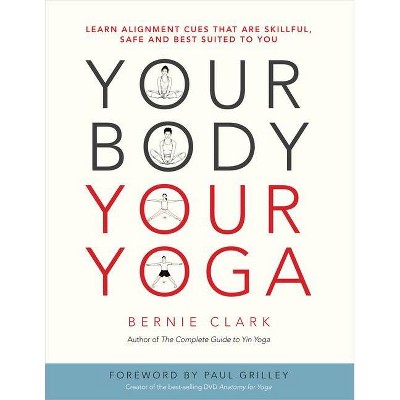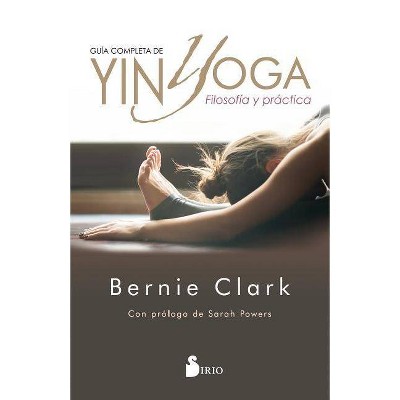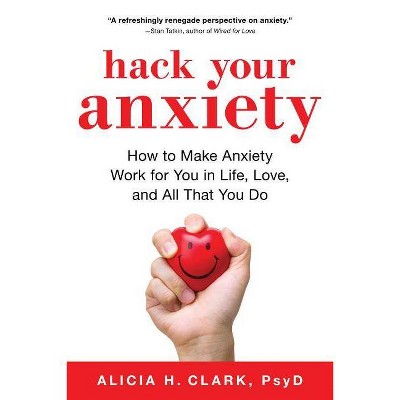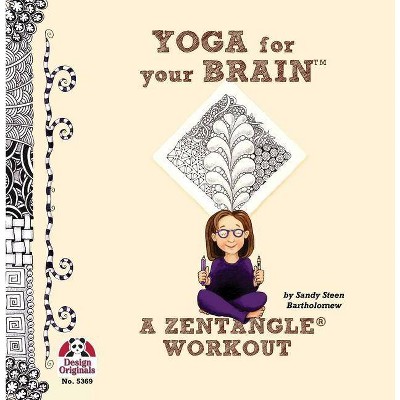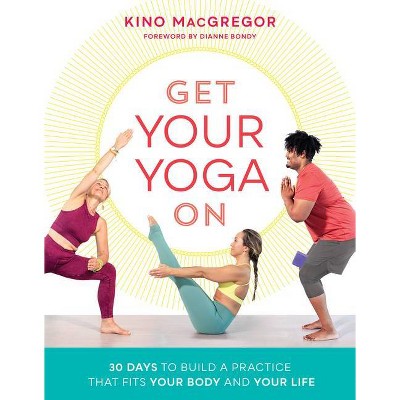Your Spine, Your Yoga - by Bernie Clark (Paperback)
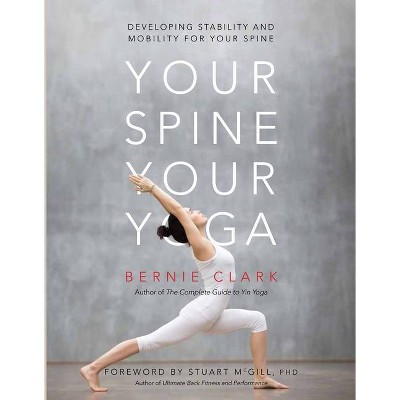
Similar Products
Products of same category from the store
AllProduct info
<p/><br></br><p><b> About the Book </b></p></br></br><em>Your Spine, Your Yoga</em> is the long-awaited second book of the <em>Your Body, Your Yoga series</em>. Focusing on the axial body, from the tip of the tailbone to the top of the skull, <em>Your Spine, Your Yoga</em> will explain how your body is unique and how this uniqueness affects your yoga practice. The latest anatomical understanding of the spine and its biomechanical abilities is described in varying levels of detail, for the novice to the experienced reader. Applying these principles to a safe and effective yoga practice holds a few surprises: you may discover that not every pose in yoga is a good idea for you, given the nature of your spine and the way we have previously been taught to stress it. Stability is more important than mobility for the vast majority of people, although many yoga classes promote the opposite view. <em>Your Spine, Your Yoga</em> offers alternative perspectives and prescriptions for a yoga practice that is spine sparing and strength building, based upon your unique biology and biography and your unique intentions<p/><br></br><p><b> Book Synopsis </b></p></br></br><em>Your Spine, Your Yoga</em> is arguably the first book that looks at the spine from both the Western anatomical/biomechanical point of view and the modern yoga perspective. It is filled with detail, discussion, illustrations, and practical advice for spines of all types. This emphasis on variety is welcome and necessary: no two spines are exactly alike, and no two people have the same biology and biography. What your spine is able to do may be vastly different from what other yoga students' or teachers' spines can do. <p/> The human spine is unique in its structure and function. Primarily, it provides stability through the core of our body, allowing forces to be transmitted from the upper body (arms and shoulders) to the lower body (pelvis and legs) and vice versa. Secondarily, the spine allows tremendous range of movement. Unfortunately, in modern yoga practice we find the primacy of these two functions reversed, with flexibility prized over stability. This focus on spinal mobility comes at a grave cost to many students. Stability is lost, and when that happens, dysfunction and pain often follow. <p/> Just as all tissues and areas of the body need a healthy amount of stress to regain and maintain optimal health, so too our spine needs the appropriate levels of stress to remain functional throughout our lives. How we choose to exercise the spine makes a difference, though. Knowing the way the spine is built, specifically, how <em>your</em> spine is built, will allow you to tailor your exercises wisely to match your goals. <p/> <em>Your Spine, Your Yoga</em> is the second book in the <em>Your Body, Your Yoga series</em> and focuses on the axial body―the core, from the sacral complex, which includes the pelvis, sacrum, and sacroiliac joint, through the lumbar and thoracic segments of the spine, to the cervical complex, which includes the neck and head. The structural components of each segment are examined: from the bones, to the joints, ligaments, fascia, tendons, muscles, and even the neurological and blood systems. The range and implications of human variations are presented, as well as the ways these variations may affect individual yoga practices. The sources of restrictions to movement are investigated through answering the question "What Stops Me?" The answers presented run through a spectrum, beginning with various types of tensile resistance to three kinds of compressive resistance. <p/> Whether the reader is a novice to yoga, anatomy, or both, or a seasoned practitioner with an in-depth knowledge in these fields, this book will be valuable. For the novice, there are easily understood illustrations and photographs, as well as sidebars highlighting the most important topics. For the anatomy geek, other sidebars focus on the complexity of the topic, with hundreds of references provided for further investigation. For the yoga teacher, sidebars suggest how to bring this knowledge into the classroom. <em>Your Spine, Your Yoga</em> can be used as a resource when specific questions arise, as a textbook to be studied in detail, or as a fascinating coffee-table book to be browsed at leisure for topics of current interest.<p/><br></br><p><b> From the Back Cover </b></p></br></br><em>Your Spine, Your Yoga</em> is a masterpiece that bridges the gaps between scientific principles of movement, body function and yoga practice. This book unlocks the cages in which the Western view of yoga has unwittingly managed to confine itself. Not too many people or yoga books I know are able to capture the messages Bernie Clark delivers informatively, creatively and resourcefully. His brilliance and yoga experience create the conduit for delivery. Bernie boldly challenges the myths around movement terms (posture, stretching, flexibility, stress, strain, stability) with scientific clarity and reasoning. The craft of this book exposes how the architectural design of the body enables it to be fluid and rhythmic with yoga practice. <p/> This book is a truly innovative contribution integrating scientific principles, the body's functional characteristics and yoga practice. I really admire the organization and presentation of the material, particularly the special sections (e.g., "It's Important," "Notes to Teachers," "It's Complicated") highlighting the important facts. It's a challenging task Bernie has undertaken, and in my view he has accomplished his goal to deliver a game changer in the yoga field. It's a groundbreaking resource to cherish. <p/> Dr. Wilbour Kelsick, Clinical Director - MaxFit Movement Institute and Post Graduate Supervisor - College of Chiropractic Sports Sciences<p/><br></br><p><b> Review Quotes </b></p></br></br><br><em>Your Body, Your Yoga</em> is not just an indispensable book--it's a long-overdue paradigm shift, and Bernie Clark continues to lead the charge with his fantastic <em>Your Spine, Your Yoga</em>. By doing the heavy lifting of collecting, organizing and contextualizing a vast amount of anatomical information, Bernie has made an essential, enduring contribution to our field. I regularly and enthusiastically recommend his work to my students. -- <em>Leslie Kaminoff - Co-author of Yoga Anatomy</em> <p/> The Rules of Alignment are wrong. Bernie's books demonstrate that error in page after page of scientific detail. We need to replace these rules with a functional approach to yoga poses, and Bernie's work shows us how to do that. The yoga community owes Bernie Clark a giant thank you for his years of work on this project. I sincerely believe his volumes have the potential to elevate our profession. -- <em>Paul Grilley - Author of Anatomy for Yoga (DVD)</em> <p/> In my teaching and practice of yoga therapy, I have come to believe in "the primacy of the spine." It unites body and breath, is crucial in health and disease, and fascinated ancient yogis, who viewed it as the gateway to transformation. Bernie Clark's comprehensive book on spinal anatomy, bringing together yoga and science, is smart, thoroughly researched and well written. I recommend it highly. -- <em> Timothy McCall, MD - Author of Yoga as Medicine</em> <p/> <b>Each time Bernie births another a book, I wonder how he could have more to say, as his last one was so thorough, and then voilà! A new gem is revealed with more in-depth areas to highlight.</b> <em>Your Spine, Your Yoga</em> is another serious buffet of information that every yoga student will want to feast on, or at least reference. It is an educational manual with a systems orientation--a holistic yin/yang view of the entire body. I particularly love the "It's Important" sidebars. It is an anatomical and functional yoga manual I am so thankful to have, and I will highly recommend that others study and imbibe its insights for a safe, informed practice and teaching. -- <em>Sarah Powers, Co-founder of Insight Yoga Institute and Author of Insight Yoga</em> <p/> <b>It's rare to come across a yoga book that's thorough, practical and evidence based but also a genuine delight to read.</b>In particular, I appreciate how Your Spine, Your Yoga is written from a perspective that's solidly grounded in yoga, yet completely and refreshingly free of pseudoscience, and that it's solidly grounded in science, yet not at all overwhelming. Bernie Clark has such a gift for making complex topics understandable, relatable and most importantly actually applicable to yoga teachers and practitioners. YSYY provided me with actionable tools that I was able to apply to my practice and teaching right away, and at the same time gave me lots to mull over and contemplate for what will likely be years to come. <p/> I also really liked the structure of the book. I found myself excitedly skipping ahead to many of the "Note to Teachers" and "It's Important" sections because they were SO very thought-provoking. Ultimately, YSYY invites teachers and students to question our preconceived notions about anatomy and alignment and reminds us that there's always more to learn. It totally squashes the dangerous and discouraging myth of universal, one-size-fits-all alignment and should absolutely be a staple in teacher training programs of all styles. -- <em>Kat Heagberg, Editor in Chief, Yoga International</em> <p/> <b>This book is a treasure. I am frankly full of admiration for Clark's accomplishment, and I am grateful to have this resource open on my desk.</b> It is an impressive addition to the <em>Your Body, Your Yoga</em> series, the first book of which was monumental in its own right. Clark dives deeply into the "axial body" in this volume and demonstrates a scope of mastery over his subject matter. His understanding of anatomy is rooted in basic principles that I appreciate as essential to my own work, and which he delivers with particular relevance to the yoga community. <p/> Clark understands the context of human anatomy and the reality of continuity, while deftly taking on the variability of our human body. This book is filled with fascinating information yet does not fall into the trap of weighing you down with information for its own sake. He conveys the importance of starting with the uniqueness that is "somebody," as opposed to the average that is literally "no body." Then he applies this principle throughout to the teaching practice of yoga instructors, in this instance around issues pertaining to the stability and function of the axial body. <p/> I have no doubt that those who spend time with this volume will find their work with students becomes safer, with injuries avoided, and more efficacious, fulfilling the intentions for which the practice of yoga is adopted. -- <em>Gil Hedley, Ph.D., Producer of The Integral Anatomy Series</em> <p/> <b>Excellently researched and chock full of detailed information, this book contains everything that you could want to know about the spine and its surrounding structures.</b> Bernie has a rare gift for making even the densest anatomical information engaging, relevant and accessible. I've been studying anatomy for years, and this book contains a multitude of insights that have changed the way I see my students and teach asana. -- <em>Rachel Scott, Educational Designer, Teacher and Writer</em> <p/> <b>All our students agree: you become a better teacher by reading Bernie's books.</b> He speaks directly to us, explaining mind-blowing science with simplicity and clarity, and offering tips and advice with wisdom and compassion. This book is incomparable. A rare gem. -- <em>Anat Geiger, Senior Yoga Teacher Trainer</em> <p/> <b>A must-read for all movement practitioners and educators!</b> YSYY showcases Bernie's meticulous research and analysis into bone morphology, explained succinctly with functional application to yoga and movement. -- <em>Jo Phee, Senior Yoga Teacher Trainer</em> <p/> <b>With a knife-sharp analytical and scientific eye, </b> combined with a light sense of humor, this wonderful and rich study contains practical explanations, many functional illustrations and different perspectives on how we can practice and teach yoga in a safe and holistic way. -- <em>Magdalena Mecweld, Creator of the Yin Yoga App and Author of Serenity Yin Yoga: Rest Yourself to a Calm Mind and Healthy Body</em> <p/> <b>Bernie Clark has done it again.</b> This is a masterpiece, bordering on the miraculous. Like your favorite professor at university, Clark will adeptly walk you through an elaborate anatomical journey that includes scientific consensus and controversy. And with each step, your knowledge will expand, be challenged and grow. YSYY deserves to be read and reread, again and again. -- <em>Josh Summers, Co-author of The Power of Mindfulness, Host of the Podcast Everyday Sublime - Shedding Light on Yin Yoga and Meditation</em> <p/> <b>"Comprehensive" is the word that springs to mind</b> while poring over YSYY. It is truly a breath of fresh air to read a work on safe and effective practices of yoga that recognizes, rather than attempts to violate, the laws of nature. Scaling laws and how body size affects safety in headstands are two of the many knockout evidence-based propositions in this book. A resource for self-practice, a guide for yoga teachers or a practical manual for teacher trainings, YSYY invites critical inquiry in a very organized, readable yet exhaustive study of the axial body. -- <em>Daniel Clement, Director, Open Source Yoga School</em><br>
Price History
Cheapest price in the interval: 26.95 on October 23, 2021
Most expensive price in the interval: 26.95 on November 8, 2021
Price Archive shows prices from various stores, lets you see history and find the cheapest. There is no actual sale on the website. For all support, inquiry and suggestion messages communication@pricearchive.us
